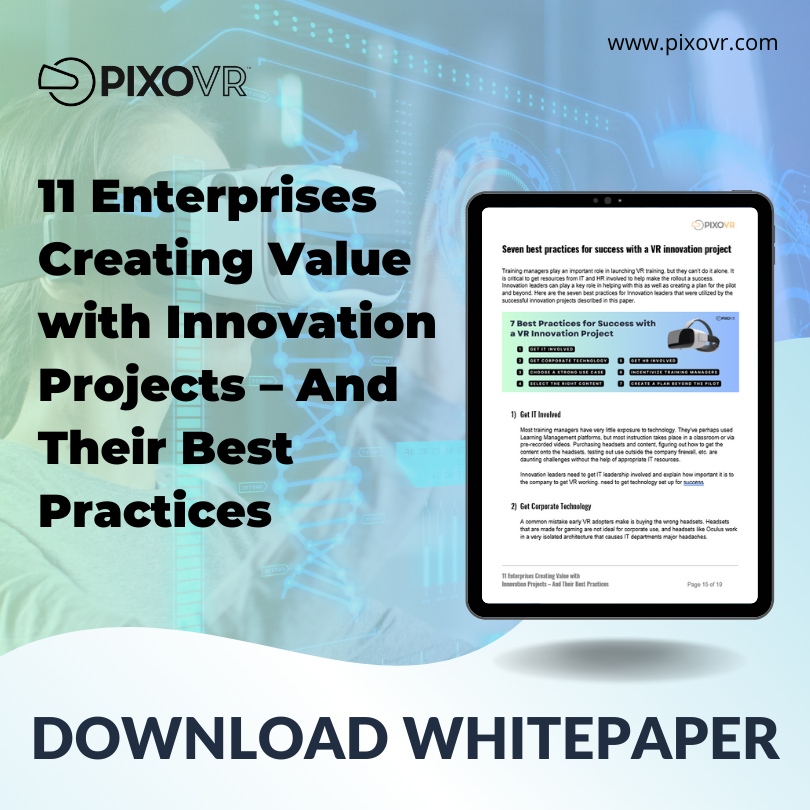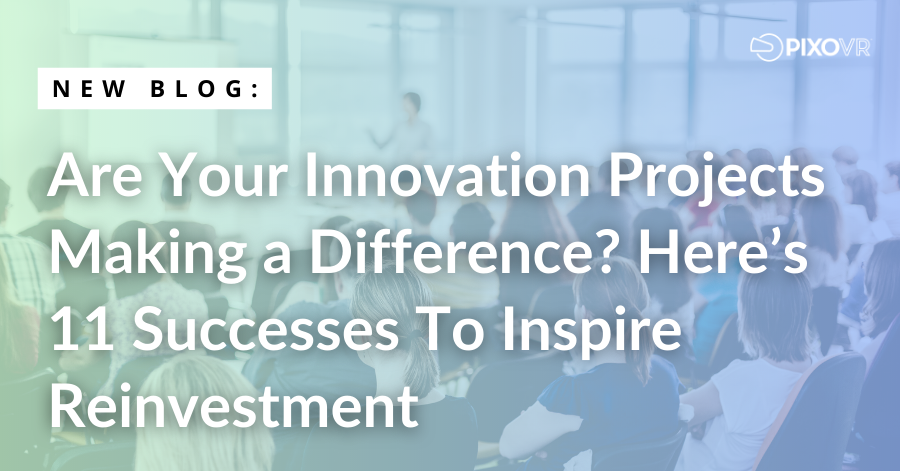For more information and to take a deeper dive into VR and how it could work for your organization, check out our FREE whitepapers, here!
Your job is important. There are a lot of incredible technologies that could drive improvements at your company. Figuring out which ones are worth the investment is difficult. Chances are you already gave virtual reality (VR) the green light. But did it go anywhere?
VR implementation commonly starts off with enthusiasm, but it fails in execution. Why? Because it’s put in the hands of individuals that have no experience with using technology who just revert back to what they’ve always been doing because it’s easier.
While this was happening at many enterprises, others were figuring it out and scoring big wins. This article will share innovation project successes that highlight where it makes sense to focus reinvestment before you fall behind the competition.
Successful implementations that reduced the skilled labor gap
A great example of using VR to reduce problems with the skilled labor gap is a global fast food chain. They were struggling to hire and the workers that were applying had no experience. Furthermore, thanks to the pandemic, many had never even been inside one of their restaurants. Training by giving 17 year olds a pdf manual wasn’t working.
The innovation team felt that VR might be used to better engage their entry-level workers and train them better. To make it work, innovation leaders coordinated IT, HR, and training resources to work together to figure out the best way to introduce VR. They worked with an experienced VR content provider to develop content on how to work their proprietary equipment and started training new hires at one location. They found VR worked to engage new hires, and even attracted additional applicants through word of mouth. The time to onboard reduced and they nearly eliminated early turnover. With initial success, they began expanding to all locations—completely changing the expectations and results of entry level onboarding.
Another example of reducing the skilled labor gap comes from a utilities provider. They could not get new hires into the field fast enough to meet demand and so the innovation team recommended VR to help. They found a VR content provider who already had standard VR training on the basics for field engineers like inside and outside meter inspection so they were able to get started quickly.
The company was blown away by a more than 50% reduction in onboarding and a 90% reduction in the time needed for job shadowing before they became fully productive. They are continuing the program and expanding to training for existing employees.
Successful implementations that reduced rework
A company that builds extremely large equipment was experiencing an increase in mistakes made in production. This was attributed at least partly to the skilled labor gap—both with new under skilled workers as well as overwork trying to continue production with resource gaps. These mistakes were being found late in the manufacturing process and causing the company millions of dollars each year in rework.
The innovation team suggested VR to help reduce production mistakes. The engineering team worked with IT and a VR content provider to create custom training to address the production issues. Workers were receptive to training in VR and since its introduction, the need for rework has continued to reduce.
Another example of reducing rework is a fast food chain that was noticing an increase in inaccurate bagging. This increase was attributed to ineffective onboarding. The chain knew their lifetime value of keeping a customer and the increase in mistakes was threatening long term revenue. The innovation team got involved and recommended trying VR training as a way for new employees to practice bagging in a life-like environment with all of the stress of needing to move quickly to keep order throughput high.
They found that new employees were much more efficient when they started working and reported bagging mistakes dropped quickly. The chain is expanding the use of VR to all employees as they move to new positions.
Successful implementations that improved worker safety
Worker safety is a costly problem for an insurance company that insures construction workers. Their head of innovation recommended that their agents try taking VR headsets out to construction sites to provide job-site safety training. There was a lot of standard VR training content available for construction so they were able to easily pilot this initiative.
The insurance company found a 100% higher engagement with the VR training compared to the training they were offering previously. They are also seeing a reduction in accidents, which is lowering premiums. So it’s a win-win for the insurance company and the construction companies they insure. In fact, they’ve heard from their clients that they are experiencing higher retention and productivity from their workers—building clear loyalty toward the insurance company.
A large pharmaceutical company also got a recommendation from the innovation lead to try VR training. They ran a pilot for lab safety training with standard VR content and saw a 25% to 30% reduction in accidents. They’ve been able to quantify an increase in productivity because people are at work and producing. They quickly expanded and also experienced a reduction in OSHA fines.
Successful implementations that reduced training costs
A large manufacturer used to send engines and engine blocks around the world to train technicians. The cost of the engine, the cost of travel, and missing work made for a very high cost of training. The innovation team had been looking for an application to test out VR and felt this was a winner as it had the potential to eliminate those high costs.
After coordinating the effort between IT, HR and training teams, with the VR content provider, they were able to create custom content to replace their training with their unique equipment. Instead, the VR content provided an experience that matched real-life. It was actually more effective as employees could get more practice time with the VR engines than they could with the in-person training. The company is now expanding use to other high-cost training to dramatically reduce costs while improving outcomes.
A large grocery chain was flying corporate employees to various stores to train them on the regional differences. This was costly in both travel and time on both the employees being trained and the host store management who conducted tours and answered questions. Executives calculated this was costing them over $27M annually just for employee time, not including travel or loss of productivity during training.
The innovation team recommended creating a VR program for their various stores that was interactive so that employees could browse through the stores and get common questions answered. After creating the content with a VR content provider, the company gained immediate and recurring annual savings without sacrificing the intent of the training.
Another example of reducing training costs is a company that manufactures building materials. They have hundreds of locations, frequent product design changes and high turnover. Because of this, thousands of employees are trained every week, which is a big hit to productivity.
An innovation leader suggested that VR could help them train faster. They worked with a VR content provider to create training on how to perform the various jobs on the line and were able to add in new materials as specifications changed. With VR they added back an average of four hours on every shift for each employee. This reduced their productivity loss from training by half, which made an impact on materials produced and overall revenue.
Successful implementations that reduced financial risk and improved employee retention
In a job market where good talent is hard to find, a large software company decided to test VR for improving soft skill training. The company saw a Pwc study on how effective VR was for soft skill training and also felt this would be a positive experience in the office for when employees came in for hybrid work. There were many standard soft skill VR training courses available, so the company started with basic communication and conflict resolution training. The training allowed employees to practice difficult conversations in a safe environment and employees could watch their own avatar performance playback.
Employees were blown away with how impactful the training was and at the innovative approach. The company noticed lower turnover than peer companies within a few months of rolling out the training and leadership feedback was clear that conflicts were lessened during this time period.
A financial institution had experienced problems with gender discrimination and harassment and were not seeing improvements with training. The head of HR collaborated with the innovation team to give VR training a try. Instead of an uncomfortable experience, employees were able to take the training in a safe space and practice having difficult conversations with people of different genders and races.
The training was able to help coach their employees on the language used and drove actionable change in gender inclusion. HR notes that complaints began rapidly decreasing, which significantly lowered financial risk. The training was so successful that the organization is looking into using VR for mindfulness training as well.
If at first you don’t succeed, try again.
These 11 examples of successful implementations of VR thanks to innovation teams is proof that VR can be successful and make a big impact on the business. The key is educating on long term value and coordinating the right resources together to handle this change. IT needs to be involved to help support this new technology. Training needs to buy-in to the value and the more strategic role they will play in the company. And HR needs to support rollout with employee education and promotion. When these resources work together, innovation investment yields big returns.
If you’ve already tried a VR innovation project, but it didn’t pan out, perhaps it’s time to try again with a new perspective and inspirational proof from the examples above. Because if you don’t get started with VR, the competition will quickly gain an advantage.
Need help getting VR right? PIXO VR can help. Click here to arrange a meeting with a VR expert.


Leave a Reply
You must be logged in to post a comment.